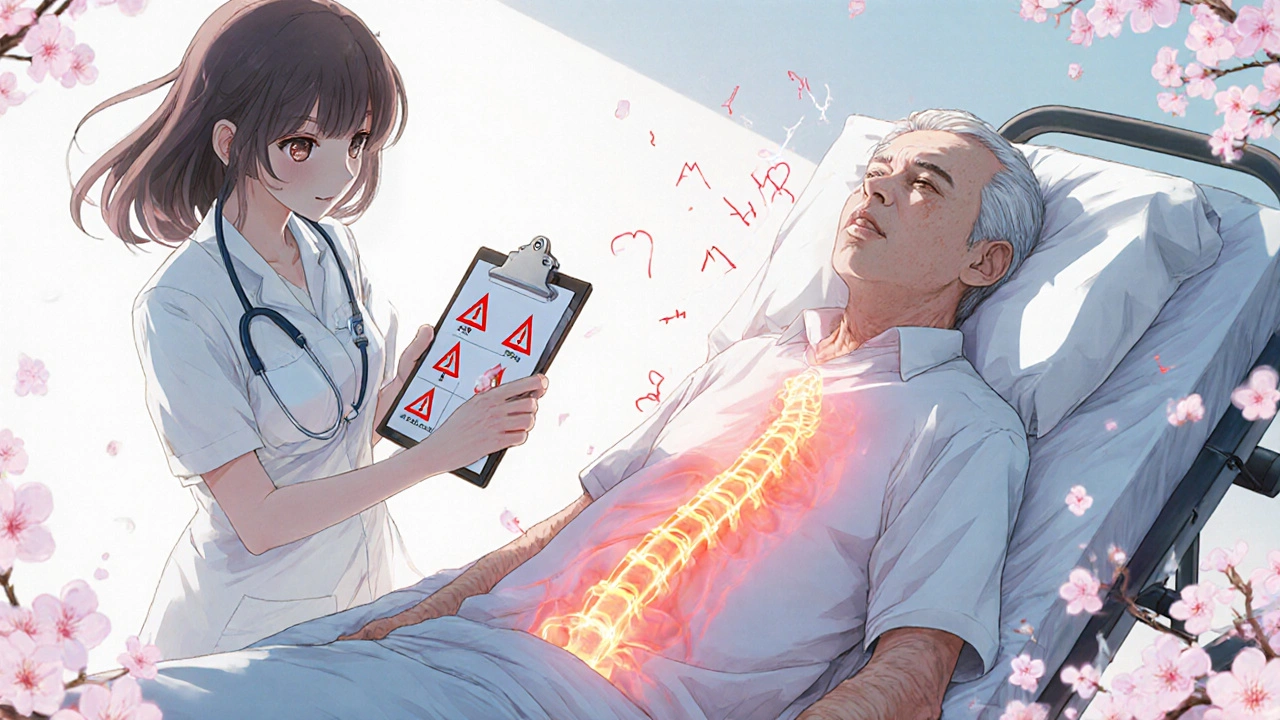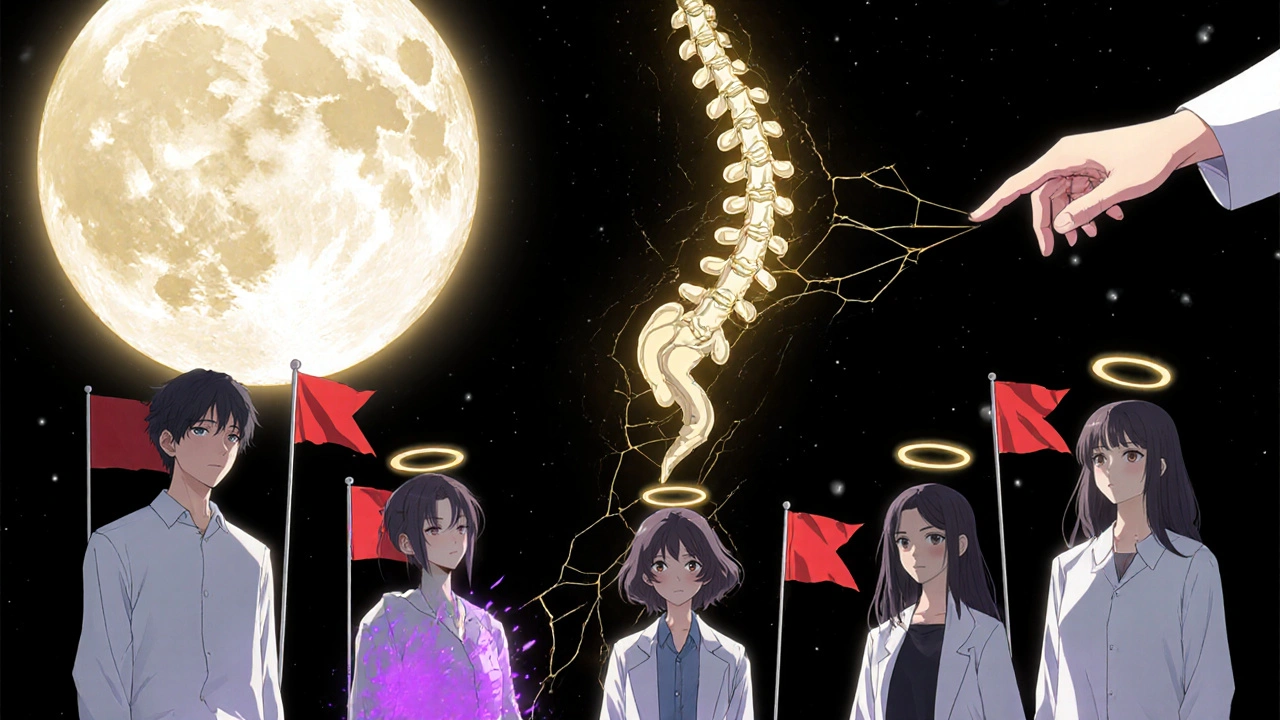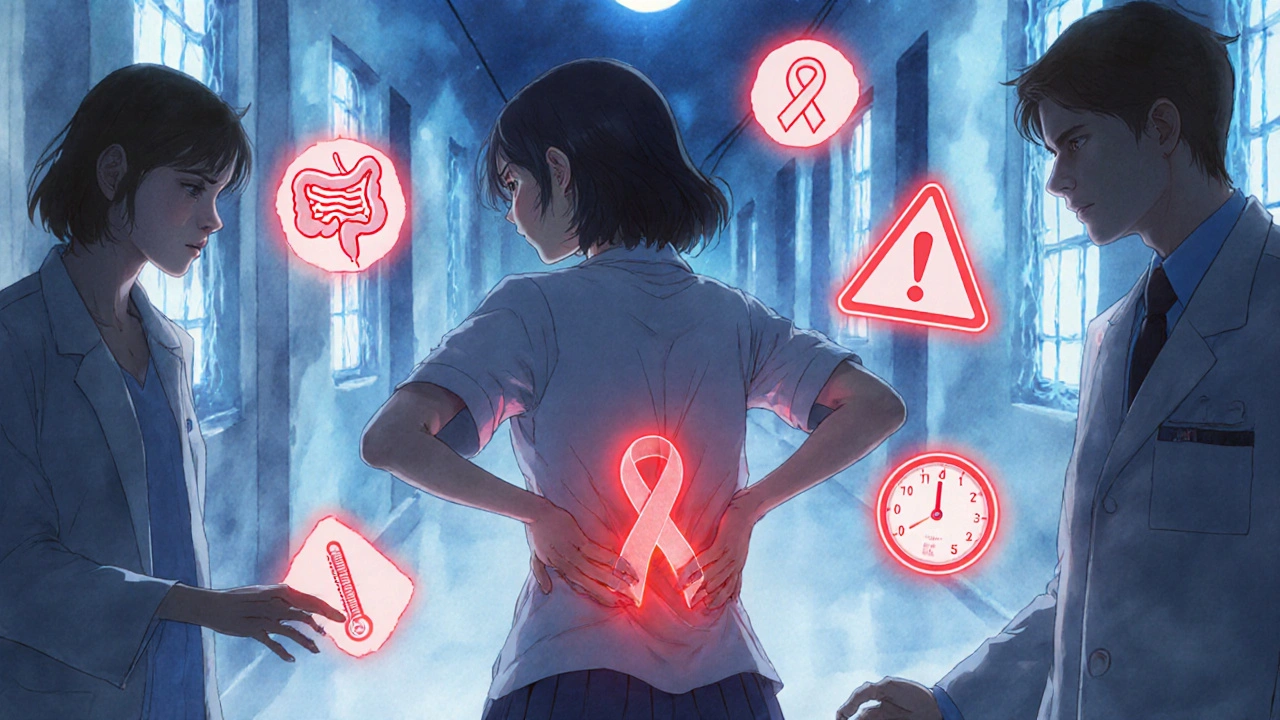Most people experience back pain at some point. It’s common, often harmless, and usually goes away on its own within a few weeks. But sometimes, back pain isn’t just a stiff muscle or a pulled ligament-it can be a warning sign of something serious. Knowing the back pain red flags can mean the difference between a simple recovery and permanent damage.
What Are Back Pain Red Flags?
Back pain red flags are clinical signals that point to potentially dangerous underlying conditions. These aren’t just vague discomforts-they’re specific symptoms that suggest infection, cancer, fractures, or nerve damage. According to guidelines from the American College of Physicians and the American College of Emergency Physicians, about 90% of back pain cases are harmless and don’t need imaging. But the other 10%? Those are the ones that can’t be missed.Ignoring these signs can lead to delayed diagnosis, worsening conditions, and even legal consequences. Studies show that 1.7% of all emergency medicine malpractice claims stem from missed spinal emergencies. That’s not a small number. It’s why doctors are trained to ask the right questions and look for the right signs.
Red Flags That Demand Immediate Attention
Not all back pain is the same. Some symptoms should send you straight to the emergency room. Here are the most critical red flags:- Cauda equina syndrome: This is a medical emergency. Symptoms include loss of bladder or bowel control, numbness in the groin or inner thighs, and sudden weakness in both legs. If you have any of these, get help immediately. Delaying treatment beyond 48 hours can lead to permanent paralysis.
- History of cancer: If you’ve had cancer before-especially breast, lung, prostate, or melanoma-and now have new back pain, it could mean the cancer has spread to your spine. The positive likelihood ratio for malignancy in these cases is between 6.4 and 54.2, depending on other symptoms.
- Unexplained weight loss: Losing weight without trying, especially with worsening back pain, is a major red flag. It’s often linked to tumors or chronic infections.
- Fever with back pain: A fever isn’t just a cold. When paired with persistent back pain, it could mean spinal osteomyelitis-an infection in the vertebrae. Studies show 67% of spinal infection cases involve fever or recent infection.
- Recent trauma or fall: If you’ve been in a car accident, fallen from height, or had a direct blow to your back, you’re at higher risk for fracture. In patients over 70, 36.5% of back pain cases are due to compression fractures, compared to just 9.1% in those under 50.
- Long-term steroid use or osteoporosis: These weaken bones. Even a minor fall can cause a fracture in someone with osteoporosis. About 45% of patients with vertebral fractures have a history of steroid use or bone density loss.
- Pain that doesn’t improve with rest or painkillers: If ibuprofen or paracetamol doesn’t help after a few days, it’s not just muscle strain. In spinal infections, 78% of patients have pain that won’t respond to standard pain relief.
Age Matters: When You’re Under 18 or Over 50
Back pain in children and teenagers is rare-and when it happens, it’s more likely to be serious. A child with back pain should always be evaluated. In adults over 50, the risk of fracture, cancer, or infection increases dramatically. A 2015 study found that 36.5% of back pain cases in people over 70 were due to vertebral fractures. That’s more than one in three.Doctors don’t automatically order scans for everyone over 50-but they do pay closer attention. If you’re over 50 and have new back pain, especially with no clear cause, it’s worth getting checked. The same goes for anyone under 18. Growing bones and developing spines can be affected by tumors, infections, or structural issues that adults rarely face.
When Is Imaging Actually Needed?
Imaging-like MRI or CT scans-isn’t a cure-all. In fact, unnecessary scans do more harm than good. The American College of Radiology says that 34% of initial back pain scans are inappropriate. They show degenerative changes that have nothing to do with the pain, leading to anxiety, more tests, and even unnecessary surgery.So when is imaging truly needed? Only when one or more red flags are present.
- For suspected infection or tumor: MRI is the gold standard. It’s 95% sensitive for cauda equina syndrome and can detect early bone infection before X-rays show anything.
- For trauma or fracture: CT scans are better than X-rays. They catch 98% of fractures in older adults, while plain X-rays miss up to 36%.
- For nerve compression: MRI shows soft tissue damage-discs, nerves, ligaments-better than any other tool.
Plain X-rays? They’re only useful in specific cases: people with osteoporosis, steroid use, or recent trauma. Even then, they’re not always reliable. A 2019 study found X-rays missed 36% of fractures in older patients.

What If Your Pain Lasts More Than a Month?
Most back pain improves within 4 to 6 weeks. If it doesn’t, it’s time to reassess. A 2018 study found that patients whose pain didn’t improve after four weeks were 19.3 times more likely to need surgery than those who got better quickly.This isn’t about panic. It’s about persistence. If you’ve tried rest, gentle movement, heat, and over-the-counter pain relief-and nothing’s changed-it’s not just “bad luck.” It could mean an underlying issue that needs a different approach. At this point, your doctor should consider red flags again, even if none were obvious at first.
What Happens After a Red Flag Is Found?
If you have one or more red flags, your next step isn’t another painkiller. It’s referral.- Emergency care: For cauda equina syndrome, spinal abscess, or sudden neurological loss-go to A&E immediately. Waiting can cost you mobility.
- Primary care referral: For cancer history, unexplained weight loss, or persistent fever, your GP will order blood tests (like ESR and CRP) and arrange imaging.
- Specialist referral: For suspected spinal tumors or complex nerve issues, you’ll be sent to a neurologist, oncologist, or spine surgeon.
Physical therapists also play a role. If they spot a red flag, they’re trained to refer you out-not to keep treating you. In fact, 12% of spinal malpractice cases involve a delay in referral.
The Problem With Overtesting
It’s tempting to want an X-ray or MRI when your back hurts. But here’s the truth: most people with back pain don’t need them. In fact, getting scanned without red flags increases costs by $300 to $500 per person-with zero improvement in recovery time.The Choosing Wisely campaign, backed by major medical groups, specifically warns against imaging for non-specific back pain. Insurance companies like Anthem now deny coverage for these scans in 42% of appealed cases.
And here’s something surprising: 79% of asymptomatic 80-year-olds have disc degeneration on MRI. That doesn’t mean they have pain. It means the scan found something normal for their age-and that can lead to unnecessary worry and treatment.

New Tools on the Horizon
The old red flag system isn’t perfect. A 2020 review found that while red flags are 96% sensitive (they catch almost all serious cases), they’re only 13% specific (they flag way too many harmless cases). That’s why new approaches are emerging.- Machine learning: The 2023 ACR update now uses algorithms to predict red flags with 89% accuracy-better than human judgment alone.
- Biomarker testing: Blood tests like CRP and ESR are being studied to detect infection faster. If CRP is above 30 mg/L and ESR over 50 mm/hr, spinal infection becomes much more likely.
- Point-of-care ultrasound: A 2022 study showed POCUS can detect bladder fullness in seconds, helping rule out cauda equina syndrome without an MRI in some cases.
These tools won’t replace the doctor’s judgment-they’ll support it. The goal isn’t to scan everyone. It’s to scan the right people, at the right time.
What You Can Do
You don’t need to be a doctor to spot danger. If you have back pain, ask yourself:- Is this pain getting worse, not better?
- Have I lost control of my bladder or bowels?
- Am I losing feeling in my legs or groin?
- Do I have a history of cancer, or am I on long-term steroids?
- Did I fall or get hurt recently?
- Have I lost weight without trying?
- Do I have a fever along with the pain?
If you answered yes to any of these, don’t wait. See a doctor. Don’t assume it’s “just a bad back.”
And if your pain lasts more than four weeks? Go back. Even if you’ve been told it’s “muscular,” persistence matters. Your body is telling you something.
What are the most dangerous back pain red flags?
The most dangerous red flags are those that signal immediate risk to nerves or life: loss of bladder or bowel control, numbness in the groin, sudden leg weakness (cauda equina syndrome), unexplained weight loss with pain, fever with back pain, and recent trauma in older adults. These require emergency evaluation.
Should I get an MRI for my back pain?
Only if you have red flags like neurological symptoms, cancer history, fever, or trauma. For most people, MRI won’t help and can lead to unnecessary worry. Up to 79% of people over 80 have disc changes on MRI-even if they feel fine. Imaging should be guided by symptoms, not fear.
Can back pain be a sign of cancer?
Yes, especially if you have a history of cancer (like breast, lung, or prostate) and now have new, persistent back pain that doesn’t improve with rest. Cancer spreading to the spine is rare, but it happens. Weight loss, night pain, and unexplained fever make it more likely.
How long should I wait before seeing a doctor for back pain?
If you have any red flags, see a doctor right away. If you don’t have red flags but your pain hasn’t improved after four weeks, it’s time to get checked. Most back pain gets better in 2-6 weeks. If it doesn’t, something else might be going on.
Is it normal to have back pain as you get older?
It’s common, but not normal. Aging brings wear and tear, but pain that’s new, worsening, or paired with other symptoms like weakness or numbness isn’t just aging. In people over 70, 36.5% of back pain is due to fractures-not just degeneration. Always get persistent or unusual pain checked.
What should I do if my GP says my back pain is ‘just muscular’ but I’m still worried?
Trust your instincts. Ask: Have I lost weight? Do I have a fever? Is the pain getting worse? If yes, insist on further checks. You can ask for blood tests (ESR, CRP) or request a referral if symptoms persist. Many serious conditions are missed because patients don’t speak up.
Can physical therapy make back pain worse?
Not if done correctly. But if you have a red flag like infection, tumor, or fracture, physical therapy can delay diagnosis and make things worse. That’s why qualified therapists screen for red flags before starting treatment-and refer out immediately if they find any.

Jenny Lee
November 19, 2025 AT 08:56Been dealing with back pain for months-no red flags, but it just won’t quit. Finally got an MRI after 6 weeks. Turns out it was a herniated disc. Don’t wait. Trust your gut.
Erica Lundy
November 20, 2025 AT 01:05The medicalization of bodily discomfort is a profound epistemological shift in modern healthcare. We now equate sensation with pathology, and silence with compliance. The red flag model, while clinically useful, risks reducing the lived experience of pain to a checklist-erasing nuance in favor of protocol.
Kevin Jones
November 20, 2025 AT 16:22Let’s be real: 90% of back pain is psychosomatic. The spine’s just a mirror for chronic stress, poor posture, and existential dread. MRI’s don’t fix anxiety. But hey, if you wanna spend $2K on degenerative changes you’ll never understand, be my guest.
Premanka Goswami
November 21, 2025 AT 13:20They don’t want you to know this-but the whole red flag system is a pharmaceutical industry ploy. Imaging? Overpriced. Referrals? Delayed. Meanwhile, your insurance gets billed $12K for a scan that shows nothing. The real red flag? The system itself.
Alexis Paredes Gallego
November 21, 2025 AT 22:01Oh wow, so now we’re supposed to panic because we have back pain? What’s next? ‘Red flags’ for sneezing? ‘Emergency referral’ for stubbing your toe? This is fearmongering dressed as medicine. I’ve had back pain for 15 years-still walking. Still breathing. Still not getting scanned.
Saket Sharma
November 22, 2025 AT 20:51Untrained PTs are the real danger. They miss 83% of red flags. Your ‘chill’ therapist is probably massaging a metastatic tumor. If you’re over 50, have any risk factor, or breathe-get an MRI. No excuses. The system is broken, but your spine isn’t.
Shravan Jain
November 23, 2025 AT 14:38the thing is… most docs dont even know the red flags. i had fever + back pain for 3 weeks. went to 3 drs. all said ‘flu’. turned out it was osteomyelitis. i lost 3 vertebrae. now i use a cane. dont trust the system. trust yourself.
Brandon Lowi
November 24, 2025 AT 15:16Look. America’s spine is collapsing-not from degeneration, but from corporate greed. Insurance denies scans. Doctors are paid by volume, not outcomes. And you? You’re just a number in a spreadsheet. If you’re in pain, you fight. You demand tests. You scream. Because if you don’t, they’ll bury you under a stack of ibuprofen and silence.
Joshua Casella
November 24, 2025 AT 23:05Thank you for writing this with such clarity. I’ve worked in primary care for 18 years, and I’ve seen too many patients dismissed too early. The most powerful thing you can do is advocate for yourself-not aggressively, but persistently. Ask for CRP/ESR. Ask for a referral. Say, ‘I’m not okay, and I need you to take me seriously.’ You’re not being dramatic. You’re being wise.
Richard Couron
November 26, 2025 AT 03:50They say ‘90% of back pain is harmless’-but who’s counting? Not the guy with the spinal tumor who got told to ‘take ibuprofen and stretch’. Not the woman whose cancer spread because her doctor was too lazy to order a scan. This isn’t medicine. It’s roulette. And you’re the one holding the gun.